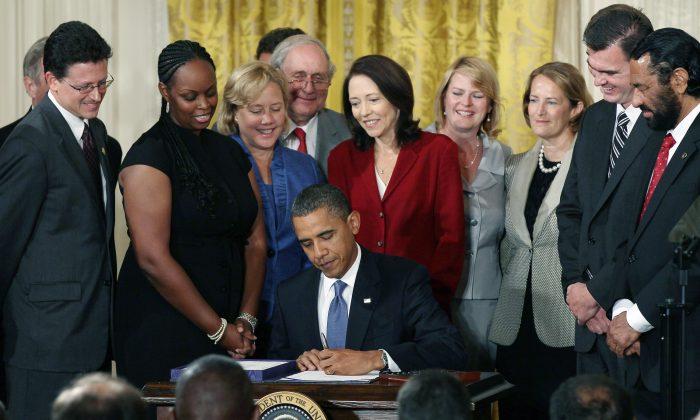The Office of the Special Inspector General for the Troubled Asset Relief Program (SIGTARP) published a report, on April 9 alleging that banks that received money from the Small Business Lending Fund (SBLF) didn’t go on to lend the funds to small businesses but used them to exit the Troubled Asset Relief Program (TARP).
“Former TARP banks in SBLF have not effectively increased small-business lending and are significantly underperforming compared to non-TARP banks,” charges SIGTARP in its report.
In 2010, President Barack Obama signed into law the Small Business Jobs Act of 2010, after it had passed the 111th United States Congress, authorizing the creation of the SBLF.
The U.S. Department of the Treasury (Treasury) was given the authority under the act to administer $30 billion. The money was to encourage small banks with assets less than $10 billion to lend funds to small businesses. To provide an incentive, the U.S. government charged a lower interest rate to these banks than it generally charges banks for funds.
Playing with SBLS Funds
Despite more than two years having passed since the establishment of the SBLF, Treasury has only disbursed about $4 billion, which is approximately 13 percent of the $30 billion. According to the SIGTARP report, Treasury dispensed $2.7 billion, or 67.5 percent, of the amount authorized to 137 banks that had received TARP funds.
The former TARP banks used $2.1 billion, about 80 percent of the SBL funds, to escape the TARP restrictions, such as executive pay and bonus payments, testified Christy Romero, special inspector general for SIGTARP, before the U.S. House Committee on Oversight and Government Reform on April 2 as published on the SIGTARP website.
Out of the 137 TARP banks 132 banks did not increase their small-business lending and 24 banks cut their small-business lending by $741 million, which was far more than the $501 million these banks received collectively from the SBLF fund.
The banks that had been provided with TARP and SBLF funds expended $1.13 for each $1 of SBL funds. On the other hand, banks that had not participated in the TARP program, but were granted SBLF funds, expended $3.45 for each $1 of SBLF funds.
SIGTARP was troubled that 14 out of the 24 small banks that reduced their small-business lending paid dividends to their stockholders
“TARP banks had much to gain and little to lose from refinancing into SBLF irrespective of their small-business lending capability or willingness to lend. If the former TARP banks fail to increase lending, there is no meaningful penalty,” testified Romero.
Treasury Disregarding Evidence and Advice
“Given that TARP status should not have been indicative of loan demand, the wide differential in applications should have been a warning sign to Treasury that TARP banks were looking to SBLF as an opportunity to exit TARP,” testified Romero.
Congress consented that TARP banks could apply for SBLF funds and permitted Treasury to select the banks that would qualify for this program, despite several members of Congress being skeptical about these banks willingness to increase their lending.
SIGTARP, in September 2010, proposed that the TARP funds received by banks should not be included when evaluating the financial wherewithal of the respective banks. SIGTARP reasoned that unless a bank was sufficiently capitalized without the TARP funds, it would not be sufficiently liquid to participate in an accelerated lending program.
For inclusion into the SBLF program, the small bank was asked to provide a plan detailing how the bank would increase lending. Although the plans were provided by all banks applying for the SBLF funds, Treasury and the regulators, despite having the expertise to conduct a thorough analysis, failed to undertake a comprehensive review of the plans.
Treasury and the regulators failed in their fiduciary duty to the taxpayer by only focusing on the continued existence of the bank and the ability to repay the SBLF funds instead of on the truthfulness of the plan’s components and the willingness to lend funds to small businesses.
There was no effective teamwork between Treasury and the regulators, as each one went at it alone, which created another obstacle toward an educated opinion on the plans.
“Treasury’s review of banks’ plans to increase lending was superficial and employed a “check-the-box” review,” testified Romero.
Loan Approvals in Numbers
A spreadsheet on the U.S. Small Business Administration (SBA) website states that loans made under the America’s Recovery Capital (ARC) Loan Program for small businesses have increased during the period beginning Jan. 1 and ending April 19, 2013, over 2012.
The SBA stated that 23,175 loans ($7.4 million) were made during 2012 and 24,054 ($9.1 million) during 2013. However the 24,054 loans granted in 2013 have not yet reached the 32,335 loans ($12.8 million) made during the same period in 2011.
The Biz2Credit small business lending index, reported on the Biz2Credit website, suggests that small banks have increased their lending activities in the last four months. In February the index was 50.3 percent, increasing by .5 percent to 50.8 percent in March.
A recent survey of U.S. bank risk managers, published on April 16 by the Fair Isaac Corporation (FICO), a credit reporting company, suggests that 62 percent of the polled managers believe that the demand for small-business loans would be met over the coming six months. Furthermore, 89 percent of these managers suggested that a greater number of small-business loans would be approved.
Despite the critical report issued by SIGTARP, putting the blame on the Treasury and U.S. regulators for certain small banks refusing to grant small-business loans, such loans appear to have been approved in greater numbers over the past months and will continue to be granted going forward.





Friends Read Free